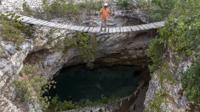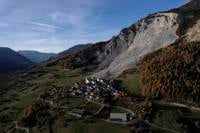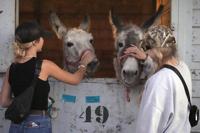HOMUN, Mexico (AP) — A huge poplar tree stands proud in Maribel Ek's courtyard, adorned with a sign that reads: “Florece desde adentro” ("It blooms from within").
Deep underground, the tree's long roots search for the water that makes this land special: a sinkhole lake, known as a cenote.
Cenotes provide an important water source to Ek's community of Homun, in the Mexican state of Yucatan, and a livelihood for locals who lead tourists from around the world into the caverns to bathe in their crystalline waters.
But more than that, cenotes are sacred to Indigenous Mayans like her.
As she descends into the cavern, Ek shines a light on a stone covered in flowers, pots, and candles —the remains of an offering she made to thank the cenote for everything it has given her. She refers to the sacred space as her “neighbor,” one that needs protection.
That belief is the basis of a lawsuit that seeks personhood status for the Ring of Cenotes, made up of hundreds of subterranean lakes that surround the northwest of the Yucatan peninsula in a semicircle, and provide the main source of freshwater in the region.
The lawsuit, from the Indigenous Mayan organization Kana’an Ts’onot, or Guardians of the Cenotes, seeks to protect the area from further contamination by industries that have moved there to take advantage of the plentiful water. The group, as designated guardians, would be able to fight on behalf of the Ring of Cenotes in court.
If they win, this would become the first ecosystem in Mexico to have its own rights, following in the wake of other cases worldwide, such as the in New Zealand or in the Brazilian Amazon.
Ek, a member of the Guardians group, speaks of the cenote and its waters as a person, as she explains the reasons behind their fight.
“Because you have to be the voice, that she doesn’t have," she said. "Because you have to be the hands, that she doesn’t have.”
Polluting the waters
The threats to cenotes have been multiplying in recent years. In addition to uncontrolled urban development and the lack of drainage in cities, new dangers include the increase in breweries and massive soybean fields and , which has embedded thousands of steel pillars in this underground paradise.
But what most worries the Guardians of the Cenotes are the pig farms.
According to Mexico’s Ministry of the Environment, 507 pig farms are operating near the Ring of Cenotes, 90% of which don’t have environmental impact studies and more than 60% that don’t have a wastewater discharge permit. That means there is no control over what happens to the thousands of liters of water filled with pig excrement and urine generated at the facilities.
In many cases, the pollutant-filled water seeps into the aquifer. The area is particularly vulnerable because the soil is karstic, made up of very thin and porous limestone full of conduits and cavities that allow everything that is dumped on the surface to filter underground, explains biologist Yameli Aguilar, master in environmental engineering from the Autonomous University of Yucatan.
A comprehensive report conducted last year by the Ministry of the Environment analyzed the water quality of 20 cenotes near pig farms and found that all of them exceeded the limits for fecal coliform (E. coli), set by Mexican authorities to protect aquatic life.
In addition, in 26 of the 51 municipalities in Yucatan where pig farms operate, they found “critical conditions for the water sustainability of the aquifer” due to high amounts of nitrogen from pig excrement and urine.
The state designates the land as a natural protected area, and it is considered a wetland of international importance by the Ramsar Convention, an organization formed around a global treaty to protect wetlands. Yet the government fails to prevent the "serious contamination” and the cenotes are suffering, said lawyer Lourdes Medina, who represents the Guardians in the process.
Ek and other cenotes’ owners created the Guardians of the Cenotes group to lead the fight against a 49,000 pig farm that was installed on the outskirts of Homun in 2017.
They organized dozens of protests, sit-ins, public consultations and legal actions, but nothing seemed to have any effect.
A year later, a lawsuit filed by six children from Homun demanding their right to water and a healthy environment succeeded in getting a judge to order the farm closed. It remains closed nowadays, but the legal battle continues.
In 2022 they filed the personhood lawsuit that would not only protect Homun, but also the other 52 communities located within the Ring of Cenotes. And it's already bearing fruit: a judge of the state of Yucatan ordered the authorities not to grant permits to any project that could impact the area until the lawsuit is resolved.
That could happen at the beginning of next year. Without protections, the group fears that their sacred cenotes will be contaminated and lose the pristine waters they depend on.
What do the pig farmers say?
Pig farms and other large industries are drawn to the area because of the availability of water. The farms use large quantities of water (about 20 liters per kilo of meat produced) to cool the animals and clean their waste.
The industry says they are not to blame for the contamination.
Carlos Ramayo Navarrete, director of the Pig Farmers Association in Merida, which represents the largest pig companies in Yucatan, said the problem is the lack of drainage in cities and the small-scale and “backyard” pig operations, because they are not as regulated by the authorities as are the bigger farms he represents.
He said around half the water the farms use is then reused. In addition, he said that all of the farms have treatment plants to reduce the load of pollutants in their wastewater, which is then used as fertilizer to irrigate fields.
“An industry that does everything within its reach and more can't be demonized,” he said.
However, both the Ministry of the Environment and Aguilar have said that the measures taken by the industry are still not enough to prevent contamination of the aquifer. “As so much (water) is used, to date there is no treatment plant that can lower the pollution load of all that wastewater,” Aguilar said.
What will the future bring?
As the lawsuits wend their way through the courts, tension between mega-farms and the local population has increased.
In 2023, the residents of Sitilpech, about 50 kilometers from Homun, took to the streets to protest against the 48,000 pig farm located on the outskirts of their village. The demonstrations were repressed by the police and resulted in the arrest of several villagers.
When a group of AP reporters approached the farm earlier this year, owned by pig giant Kekén, they saw a security guard with a machete in his hand at the entrance.
The Sitilpech house closest to the farm is small and painted green, with a porch overlooking the road and a banner written in capital letters demanding that the pig farm leave.
In the backyard, Marcela Chi Eb has just put in a washing machine and is hanging clothes on ropes supported by two lemon trees. Their leaves are dry and brownish; she said they got that way when the farm started operating.
At night she is awakened by the farm's stench and, although the heat is unbearable, she closes the windows to keep out the smell that permeates her nose and clothes.
While one of her daughters rests in a hammock, Chi Eb talks about what worries her most: that in the future neither she nor her children will be able to use the water that comes from the faucet in her house.
Back in Homun, Maribel Ek reaches the end of the cavern and, without a second thought, dives into the turquoise waters of the cenote.
As a child she came down here every day to collect water because the public supply didn’t reach her house.
Since then she learned this wasn't just “a dark hole with bats,” but “a blessing, a dark hole that becomes a friend,” she says. “That's why we demand rights for our cenotes.”
___
Follow Teresa de Miguel on X at
___
Read more of AP’s climate coverage at
___
The Associated Press’ climate and environmental coverage receives financial support from multiple private foundations. AP is solely responsible for all content. Find AP’s for working with philanthropies, a list of supporters and funded coverage areas at .
















































